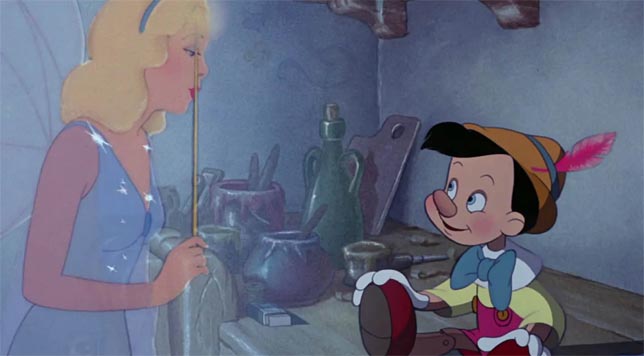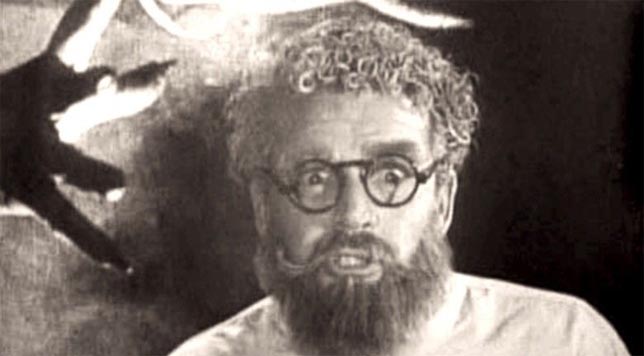I Walked with a Zombie (1943). 69 minutes. Directed by Jacques Tourneur. Starring Frances Dee (as Betsy Connell), Tom Conway (as Paul Holland), James Ellison (as Wesley Rand), Edith Barrett (as Mrs. Rand), James Bell (as Dr. Maxwell), Christine Gordon (as Jessica Holland), Theresa Harris (as Alma), Darby Jones (as Carrefour), and Sir Lancelot (as calypso singer). Produced by Val Lewton.
I Walked with a Zombie has a sensationalistic title, but don’t let that fool you—this is not a 1950s atom bomb movie about flesh-eating ghouls. The story follows a strange woman living on a balmy island who wanders around in a kind of trance, whether due to tropical fever or vengeance or voodoo (or all three). The true nature of her condition is never made entirely clear, and rather than prove to us definitively that the woman is a zombie, the movie instead cultivates a moody atmosphere where much is unsaid, sorrow pervades, and we are left to draw our own conclusions. In this way, I Walked with a Zombie is similar to other Val Lewton movies such as Cat People (1942) and The Curse of the Cat People (1944), which emphasize psychology and the unknown over more explicit horror; and yet the world of I Walked with a Zombie is somehow even more compromised than those other universes, its characters even more mired in hopelessness and melancholy. Watching it, I was reminded of how uniquely sensitive Lewton’s horror movies can be.
Betsy Connell is a Canadian nurse who accepts a job caring for a sick woman on the Caribbean island of St. Sebastian. As she journeys to the island by boat, she meets the woman’s husband, Paul Holland, who tells her that St. Sebastian is full of suffering. Once on the island, she meets Paul’s half-brother, Wesley Rand, and her charge, Jessica Holland, who lives in a perpetual trance and often sleepwalks. The Holland-Rand family owns a sugar plantation and Mrs. Rand, the matriarch, works as a doctor on the island.
Betsy is bewildered by Jessica’s strange state. In town she hears a calypso performer singing about the family; the song implies that Wesley had an affair with Jessica and was going to run off with her, but something sinister occurred to stop them, possibly at the hands of Paul. The message of the song complicates Betsy’s feelings—she is falling in love with Paul, and in order to please him does everything she can to restore Jessica to her former health. When Jessica fails to make any improvements, Betsy seeks out the help of the local voodoo community through the maid Alma. But when Betsy is received by the witch doctor in private quarters, she learns that the doctor is really Mrs. Rand, who poses as a voodoo authority in order to administer Western medicine. Meanwhile, the locals pierce Jessica’s arm and see that she neither bleeds nor reacts. The next day the government wants an investigation into Jessica’s state. Mrs. Rand confesses to her family that she made Jessica a zombie when she learned Jessica was going to break the family apart, but Jessica’s personal physician Dr. Maxwell assures her that this is impossible because Jessica has never died (a strange claim for a Western doctor to make). As pressure mounts from the locals and the government to do something about Jessica’s spooky behavior, Wesley becomes obsessed with freeing her from her illness. He takes it upon himself to end Jessica’s life and his own near the sea. In the film’s final shot, we see their bodies being carried back inside the Holland estate.
There are so many competing explanations for how Jessica came to be as she is. Dr. Maxwell first tells Betsy that Jessica’s spinal cord has been affected by a dire sickness. The calypso singer says Jessica had a fever and implies that Paul did something to her in her weakened state. Paul tells Betsy that he may be the reason Jessica became incapacitated. Mrs. Rand claims to have been possessed by a voodoo spirit and to have cursed Jessica when she learned her daughter-in-law was going to run off with Wesley. The locals suspect, based on the fact that they stab her and she does not react, that she is a zombie, and they want to conduct further tests on her—however, our view of her arm when they stab her is obscured.
But is she really a zombie? It is true that a voodoo official makes a doll of Jessica and draws it towards him on her final night, and she does get up and leave the Holland estate. She has, however, also gotten up and tried to leave so many times before. What are we to believe? The movie does not offer us any solid, reliable sources to establish the truth. Neither Paul nor Wesley is wholly forthcoming about the past, and even the seemingly skeptical Mrs. Rand, who is so critical of voodoo for most of the film, is also too emotionally wound up in her own narrative to be trustworthy. We might be tempted to rely on outsiders like the calypso singer for information—but is he conveying something he has personal knowledge of, or is he simply repeating local lore? The most reliable person is perhaps Betsy, but even she does not exercise the best judgment. Taking Jessica to the voodoo site is a bad idea, and she should have considered the consequences of exposing Jessica to the wider community.
Jessica the possible zombie is beautiful, with long hair, flawless skin, and enviable nighttime attire that billows behind her in the evening air. She must be accompanied by her own private wind machine, because her wardrobe flutters around her in all environments, even indoors. Yet there is more to Jessica than her appearance. Her constant presence is a reminder of the past, of things that have gone wrong, of mystery and the unknowable. Her silence makes her a canvas onto which people can project whatever they wish; she is like the empty seat at the dining room table that Wesley points out when he first gives Betsy a tour of the house. The calypso musician can sing his song about what happened to her regardless of its veracity. Betsy can see her love for Paul in Jessica’s frail state. Alma can dress her up and care for her much as she does her sister’s baby. For Paul, Jessica is a lingering source of suffering that he cannot get rid of but would be happy to see gone. Wesley wants her to live as a reminder of his former passion—that is, until he decides she should die. As a kind of living specter, she exhibits both the power of something that haunts us and the powerlessness and vulnerability of someone whose primary significance has to be filled in by others.
Just as the characters apply their own narratives and needs to Jessica, I found myself projecting well-known literary archetypes onto her story. Because she is an estranged female who is always lurking on the Holland estate and whose potential escape is of concern, Jessica reminds me of Mr. Rochester’s mad wife in Charlotte Brontë’s Jane Eyre, whose presence hovers over the Rochester household. Insofar as Jessica is also someone whom Betsy the servant thinks is an ideal wife at first, I was also reminded of Daphne du Maurier’s novel Rebecca, which was adapted for film by Alfred Hitchcock in 1940. The protagonist of that story is convinced that her new husband Maxim worships his dead wife Rebecca; she is encouraged to think that in part because of the housekeeper Mrs. Danvers, who is obsessed with her former mistress. What the protagonist does not know is that Maxim secretly hated Rebecca. Here, too, despite Betsy’s initial impression, Paul Holland is not wild about his possibly zombified wife; it is his brother Wesley who is. Part of what Betsy has to learn is that Paul can have compassion for Jessica even though he is not in love with her any longer, whereas Wesley can behave cruelly towards Jessica even though he claims to love her. It is a world of topsy-turvy behavior.
The housekeeper Mrs. Danvers is an essential character in Rebecca, and in I Walked with a Zombie, Alma the maid also plays an important role. Alma is part of the island’s black community and serves as Betsy’s guide through its culture. The black locals (who constitute a majority on St. Sebastian) are mostly nameless and largely do not speak. What we see and hear them do without words is mysterious and evocative: the hypnotic gatherings that take place in another world beyond the maze-like sugar cane fields, the ominous drumming, the rhythmic dancing. These striking sights and sounds help to define black activity in the film as something that is separate, secretive, and unfamiliar. But the locals are also differentiated through less exotic contexts. When we first encounter Alma, we learn she is sobbing in the night because her sister has just had a baby. The Hollands tell Betsy with befuddlement that the locals behave this way in response to their historical condition: crying because one of their own has been born into hardship and laughing whenever one of them dies because they are finally free from earthly servitude.
The white residents do not understand very much about their non-white neighbors in general. During one scene, when the locals are drumming loudly and Paul and Wesley try to prevent Jessica from leaving the property in her trance-like state, Paul says that there is nothing to fear—voodoo is not real, the locals make things up, and their beliefs are mumbo jumbo. Wesley contradicts him, saying that the black islanders are dangerous and the Hollands do not know what they are capable of. The family thus teeters between two unflattering views of its neighbors: on the one hand, condemning them for irrationality, and on the other hand, fearing their supernatural powers.
The Hollands have a reason to feel insecure. Their history is inextricably bound up with slavery and exploitation. We learn, for example, that the Holland family brought over African slaves to the island and that the statue of St. Sebastian (i.e., of the saint pierced through with the arrows of his martyrdom) in the Holland garden is the masthead from the family slave ship. The fact that the ship’s mast is on display as a yard artifact is sad and disturbing. It conveys the placid acceptance of horror and pain on a symbolic level. What’s more, as a vivid rendering of the martyrdom of St. Sebastian (with arrows that are apparently, as we later see, removable and used to kill Jessica) the statue is an explicit and interactive reminder of injustice and suffering. The St. Sebastian statue thus combines the pain of two cultural identities—early Christians and African slaves—to convey a complex network of sorrows. Because the Hollands are not obvious participants in the first of those contexts and clearly do not belong to the second, they would seem to be outside of the sphere of the masthead’s image of suffering. And because we know that their family inflicted the pain that the masthead represents, and because we see that they display it in a strange context that implies a lack of feeling or respect for what it depicts, we might feel that the Hollands are owed some contempt. But at the same time, the movie invites us to see signs of the Hollands’ own version of suffering: a recent and disturbing past that cannot be fully articulated, romantic betrayal, the denigration of family relationships due to lies. Their suffering is inexplicably tied to the suffering that they have inflicted on others, either in their own lifetime or in previous generations.
Val Lewton’s films often leave us wondering about precise explanations for their horror. The Curse of the Cat People similarly makes us question the nature of an important character, who may or may not be a ghost. Whereas that movie’s reluctance to pinpoint her identity ultimately seemed like a weakness, I Walked with a Zombie’s flirtation with Jessica’s possible occult identity seems to be more a reflection of a world in which there are no set or easy answers. The movie begins with Paul telling Betsy that she is about to enter a world of sorrow, where there is no beauty. The first half of his pronouncement seems to be the one constant—all roads lead back to it. But there is one thing he gets wrong: there is a great deal of beauty in this story. I locate beauty not merely in the look of the film, which is staged and photographed with a care and thoughtfulness that are greater than its minor budget; but also in its willingness to intrigue us with uncertainty, perplex us with overlapping narratives, and puzzle us with mysterious accounts. I Walked with a Zombie understands that the unknown is thrilling, suggestion is powerful, and horror is laced with sadness. That might seem like an unusual worldview to us if we have been reared on modern horror films that excel at explicit depictions of gore and violence, but it is a very typical worldview for a Val Lewton movie to espouse. It is only one reason why his work is so special.







